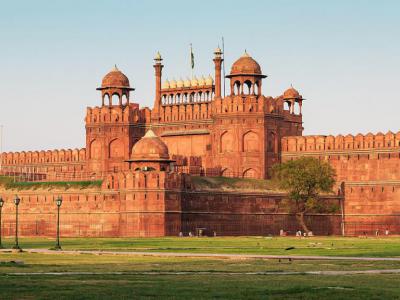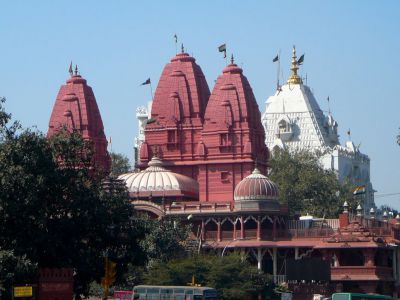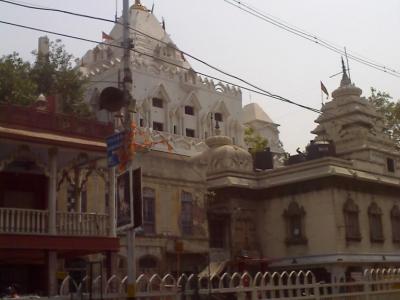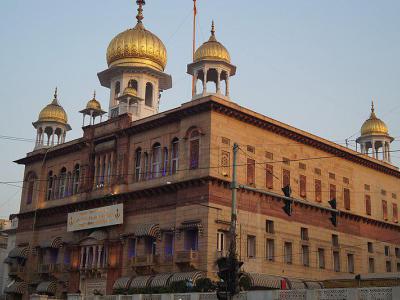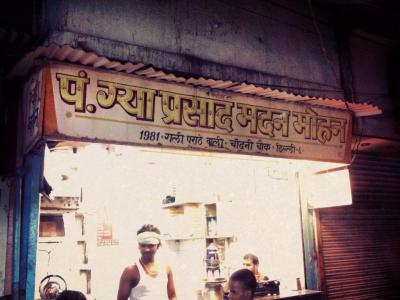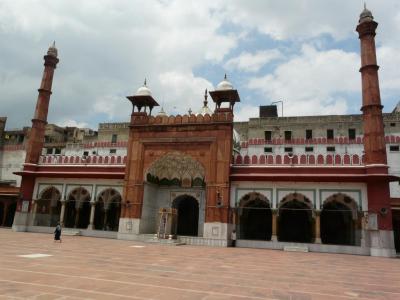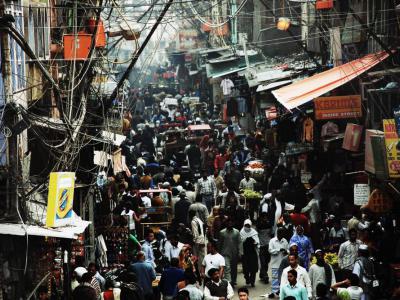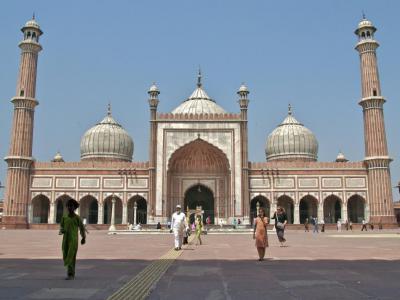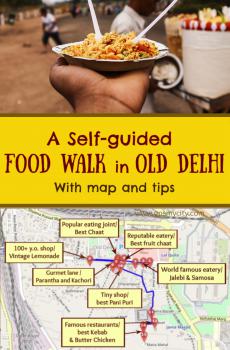
Old Delhi Walking Tour (Self Guided), Delhi
Old Delhi, as a walled city, was founded in 1639 under the Mughal emperor Shah Jahan, who decided to move his domain's capital here from Agra. The construction of the city was completed in 1648, from which point on Delhi had remained the capital of the Mughal Empire until its fall in 1857.
Once filled with mansions and havelis (traditional townhouses) of the nobles and members of the royal court, situated alongside elegant mosques and gardens, Old Delhi was also known for its bazaars and street food.
Red Fort, the former residence of Emperor Shah Jahan, is the most popular attraction in Old Delhi. On 15 August 1947, an Indian national flag was raised above the fort, symbolizing the independence of India as a nation, for the first time. Jama Masjid or Friday Mosque, the most notable piece of Islamic architecture, is found in the center of the city.
If you want to experience firsthand a busy Indian market, check out Chandini Chowk. This market was built by Emperor Shah Jahan and designed by his daughter Jahanara. The place was once divided by canals to reflect moonlight, hence it is also called Moonlight Square.
Old Delhi is crowded and chaotic. If you are an adventurous type and would like to explore this exciting place at your own pace, take our self-guided walking tour to discover the most famous attractions of Old Delhi!
Once filled with mansions and havelis (traditional townhouses) of the nobles and members of the royal court, situated alongside elegant mosques and gardens, Old Delhi was also known for its bazaars and street food.
Red Fort, the former residence of Emperor Shah Jahan, is the most popular attraction in Old Delhi. On 15 August 1947, an Indian national flag was raised above the fort, symbolizing the independence of India as a nation, for the first time. Jama Masjid or Friday Mosque, the most notable piece of Islamic architecture, is found in the center of the city.
If you want to experience firsthand a busy Indian market, check out Chandini Chowk. This market was built by Emperor Shah Jahan and designed by his daughter Jahanara. The place was once divided by canals to reflect moonlight, hence it is also called Moonlight Square.
Old Delhi is crowded and chaotic. If you are an adventurous type and would like to explore this exciting place at your own pace, take our self-guided walking tour to discover the most famous attractions of Old Delhi!
How it works: Download the app "GPSmyCity: Walks in 1K+ Cities" from Apple App Store or Google Play Store to your mobile phone or tablet. The app turns your mobile device into a personal tour guide and its built-in GPS navigation functions guide you from one tour stop to next. The app works offline, so no data plan is needed when traveling abroad.
Old Delhi Walking Tour Map
Guide Name: Old Delhi Walking Tour
Guide Location: India » Delhi (See other walking tours in Delhi)
Guide Type: Self-guided Walking Tour (Sightseeing)
# of Attractions: 8
Tour Duration: 2 Hour(s)
Travel Distance: 3.3 Km or 2.1 Miles
Author: doris
Sight(s) Featured in This Guide:
Guide Location: India » Delhi (See other walking tours in Delhi)
Guide Type: Self-guided Walking Tour (Sightseeing)
# of Attractions: 8
Tour Duration: 2 Hour(s)
Travel Distance: 3.3 Km or 2.1 Miles
Author: doris
Sight(s) Featured in This Guide:
- Red Fort
- Sri Digambar Jain Lal Mandir
- Gauri Shankar Temple
- Gurudwara Sis Ganj Sahib
- Paranthe Wali Gali (Flatbread Lane)
- Fatehpuri Masjid
- Chandini Chowk Market
- Jama Masjid (Friday Mosque)
1) Red Fort (must see)
The historic Red Fort in Delhi was once home to the Mughal emperors of India. It was commissioned by Shah Jahan in 1638 when the capital moved to Delhi from Agra. It is so named due to the red sandstone walls that surround the structures.
The Red Fort architect was Ustad Ahmad Lahori, who was also architect of the Taj Mahal. It was designed in Indo-Islamic architectural style, but many of the buildings have Mughal influences that combine Hindu, Persian and Timurid styles.
The fort has suffered from theft and destruction over the years. For example, the Diwan-i-Khas once had a ceiling made from silver, but it was removed and melted in 1760. Most of the marble structures in the fort were destroyed during the Revolt of 1857.
Red Fort once held a large amount of jewels and artwork. Nearly all of these valuables were stolen and now belong to private collectors or reside in British museums.
Despite all of the plundering and warfare that has taken place over the years, the defensive walls have remained mostly intact. The Red Fort Complex has now been named a UNESCO World Heritage Site. As it is the largest monument in Delhi, it is also one of the most popular tourist destinations.
The structures still standing at Red Fort are Lahori Gate, Delhi Gate, Chhatta Chowk, Naubat Khana and a number of halls, homes and apartments. There is also a bath house, a step-well, a reservoir and the Pearl Mosque.
There is a light and sound show displayed each evening that describes Mughal history. The show takes place at 6 PM and is in both English and Hindi.
Why You Should Visit:
- To see Delhi's largest monument
- To explore a historic fort that still has many building intact
Tips:
Red Fort is open from sunrise to sunset. The entry fee is 950 rupees (approximately $13 USD), though this amount may fluctuate. There is an additional, nominal fee for the light show. Red Fort is closed on Mondays.
The Red Fort architect was Ustad Ahmad Lahori, who was also architect of the Taj Mahal. It was designed in Indo-Islamic architectural style, but many of the buildings have Mughal influences that combine Hindu, Persian and Timurid styles.
The fort has suffered from theft and destruction over the years. For example, the Diwan-i-Khas once had a ceiling made from silver, but it was removed and melted in 1760. Most of the marble structures in the fort were destroyed during the Revolt of 1857.
Red Fort once held a large amount of jewels and artwork. Nearly all of these valuables were stolen and now belong to private collectors or reside in British museums.
Despite all of the plundering and warfare that has taken place over the years, the defensive walls have remained mostly intact. The Red Fort Complex has now been named a UNESCO World Heritage Site. As it is the largest monument in Delhi, it is also one of the most popular tourist destinations.
The structures still standing at Red Fort are Lahori Gate, Delhi Gate, Chhatta Chowk, Naubat Khana and a number of halls, homes and apartments. There is also a bath house, a step-well, a reservoir and the Pearl Mosque.
There is a light and sound show displayed each evening that describes Mughal history. The show takes place at 6 PM and is in both English and Hindi.
Why You Should Visit:
- To see Delhi's largest monument
- To explore a historic fort that still has many building intact
Tips:
Red Fort is open from sunrise to sunset. The entry fee is 950 rupees (approximately $13 USD), though this amount may fluctuate. There is an additional, nominal fee for the light show. Red Fort is closed on Mondays.
2) Sri Digambar Jain Lal Mandir
Situated opposite Red Fort in Delhi, Digambar Jain Lal Mandir was originally built in 1526 during the reign of Mughal Emperor Jahangir. This temple has since undergone various modifications. The temple was constructed without the Shikara as the Mughal Emperor did not permit its construction. The shikaras were added on only after India obtained independence. The main deity of this temple is Tirthankara Parashvanath. The temple is famous for its fine carvings and decorative paint-works.
Once you enter the temple, the Manastambha column will welcome you. The main prayer hall is located in the first floor of the temple. You must first cross a small courtyard, which is encircled by an arcade. Apart from the main shrine dedicated to Tirthankara, there are many other shrines. One of the important shrines is the one dedicated to Lord Adinath. The temple is known for its soothing ambiance. Pilgrims and tourists flock here to enjoy its calm atmosphere. The divine aura is enhanced with candle lights and butter lamps. The walls of the shrine are decorated with glided paintwork.
You can find a bookstore with a huge collection of books inside the temple. Paryushan, Deepawali and Jnaan Panchami are the important festivals observed here. There is a Bird’s hospital inside the temple, which contains separate wards for parrots, pigeons, sparrows and domestic fowl.
Once you enter the temple, the Manastambha column will welcome you. The main prayer hall is located in the first floor of the temple. You must first cross a small courtyard, which is encircled by an arcade. Apart from the main shrine dedicated to Tirthankara, there are many other shrines. One of the important shrines is the one dedicated to Lord Adinath. The temple is known for its soothing ambiance. Pilgrims and tourists flock here to enjoy its calm atmosphere. The divine aura is enhanced with candle lights and butter lamps. The walls of the shrine are decorated with glided paintwork.
You can find a bookstore with a huge collection of books inside the temple. Paryushan, Deepawali and Jnaan Panchami are the important festivals observed here. There is a Bird’s hospital inside the temple, which contains separate wards for parrots, pigeons, sparrows and domestic fowl.
3) Gauri Shankar Temple
This temple is located on Chandni Chowk road in Delhi and is one of the most noteworthy temples for devoted to Lord Shiva. It houses an 800 year old lord Shiva’s manifestation-Lingam. The lingam is surrounded by snakes made of silver. A water vessel made of silver is placed above the lingam, from which water drops fall over it continuously.
According to legends, Apa Gangadhar, a devotee of Shiva was badly injured in a battle. His chance of survival was very low. He prayed to God and promised that he would build a Shiva temple, if he survives. Gangadhar survived and he built this temple to show his gratitude to the lord for saving his life. You can see his name inscribed at the end of the spire near the entrance.
The idols of Lord Shiva, his wife Parvati and his two sons, Ganesh and Kartik are housed in the temple. The life of Shiva is beautifully narrated on the walls of the temple. The most important attraction of this temple is the marble chair of a Hindu saint named Bhagat Swaroop Bramhachari, who spent most of his life in the temple. His teachings, portrait and sandals are preserved in this temple. Monday is the most auspicious day to visit the temple.
According to legends, Apa Gangadhar, a devotee of Shiva was badly injured in a battle. His chance of survival was very low. He prayed to God and promised that he would build a Shiva temple, if he survives. Gangadhar survived and he built this temple to show his gratitude to the lord for saving his life. You can see his name inscribed at the end of the spire near the entrance.
The idols of Lord Shiva, his wife Parvati and his two sons, Ganesh and Kartik are housed in the temple. The life of Shiva is beautifully narrated on the walls of the temple. The most important attraction of this temple is the marble chair of a Hindu saint named Bhagat Swaroop Bramhachari, who spent most of his life in the temple. His teachings, portrait and sandals are preserved in this temple. Monday is the most auspicious day to visit the temple.
4) Gurudwara Sis Ganj Sahib
Situated in Old Delhi's Chandni Chowk, Gurudwara Sis Ganj Sahib was established in 1783 by Baghel Singh as a tribute to the Sikh Guru, Tegh Bahadur. Tegh Bahadur was tragically executed under the orders of the Mughal emperor, Aurangzeb, as he vehemently opposed the forced conversion of Kashmiri Pandits and other dharmic individuals to Islam. The Gurudwara was later constructed on the site of his martyrdom. Another significant historical event at this sacred place was when Guru Gobind Singh visited in 1702.
Within the shrine, visitors can see the preserved trunk of the tree where Guru Tegh Bahadur's head was severed, as well as the well he used during his imprisonment for bathing. Adjacent to the Gurudwara stands the Kotwali (police station) where Guru Tegh Bahadur was held captive and his disciples were subjected to torture before their execution.
An unmissable attraction near the Gurudwara is the museum on the opposite side, offering insight into the captivating history that makes for an intriguing story to share with the kids. The museum is named after Bhai Mati Das, Bhai Sati Das, and Bhai Dyal Das, who were devout followers of Guru Tegh Bahadur and also faced execution by Aurangzeb's decree.
Why You Should Visit:
Smaller than Bangla Sahib, this is another beautiful and peaceful gurudwara where everyone is welcome. It is also very colorful.
Tip:
Be sure to peek into the kitchen & serving area (right opposite the very clean toilets behind the main building), where anyone regardless of faith is served a vegetarian meal, as in all gurudwaras.
Within the shrine, visitors can see the preserved trunk of the tree where Guru Tegh Bahadur's head was severed, as well as the well he used during his imprisonment for bathing. Adjacent to the Gurudwara stands the Kotwali (police station) where Guru Tegh Bahadur was held captive and his disciples were subjected to torture before their execution.
An unmissable attraction near the Gurudwara is the museum on the opposite side, offering insight into the captivating history that makes for an intriguing story to share with the kids. The museum is named after Bhai Mati Das, Bhai Sati Das, and Bhai Dyal Das, who were devout followers of Guru Tegh Bahadur and also faced execution by Aurangzeb's decree.
Why You Should Visit:
Smaller than Bangla Sahib, this is another beautiful and peaceful gurudwara where everyone is welcome. It is also very colorful.
Tip:
Be sure to peek into the kitchen & serving area (right opposite the very clean toilets behind the main building), where anyone regardless of faith is served a vegetarian meal, as in all gurudwaras.
5) Paranthe Wali Gali (Flatbread Lane)
Paranthe Wali Gali, also known as Flatbread Lane, is a small street in the Chandni Chowk market district that is known for its series of parantha shops. Though the street was originally a mainstay of silver and jewelry merchants, the parantha shops have been in steady operation since the mid-19th century.
Through the 1960s, about 20 different parantha shops operated on Flatbread Lane. Today, there are three shops that focus on selling parantha, though more are regularly reappearing.
Parantha is a traditional Indian food whose name means "layers of cooked dough." They are sometimes sold plain, but often those of the northern Indian region are stuffed with fillings that might consist of nuts, legumes, potato, cheese or cauliflower. They are generally served alongside a series of dipping sauces and ordered with a lassi to drink.
Parantha goes by many different names. It may be spelled paratha, parauntha, paronthi or even farata, depending on the location.
Through the 1960s, about 20 different parantha shops operated on Flatbread Lane. Today, there are three shops that focus on selling parantha, though more are regularly reappearing.
Parantha is a traditional Indian food whose name means "layers of cooked dough." They are sometimes sold plain, but often those of the northern Indian region are stuffed with fillings that might consist of nuts, legumes, potato, cheese or cauliflower. They are generally served alongside a series of dipping sauces and ordered with a lassi to drink.
Parantha goes by many different names. It may be spelled paratha, parauntha, paronthi or even farata, depending on the location.
6) Fatehpuri Masjid
Fatehpuri Masjid is located near Chandni Chowk in Delhi. Built by Fatehpuri Begum, wife of Shah Jahan in 1650, the mosque is renowned for its magnificence and historical significance. This mosque has a single dome which is flanked by two minarets. It was built with lime mortar and entrenched with black and white stripes.
Fatehpuri mosque features a traditional design. It has a prayer hall with seven arched openings. It also has single as well as double storied apartments on both sides. The courtyard is made of red sandstone. The exquisite sandstone pillars on either side of the mosque are the finest features of this building.
This mosque was used by Indian troops during the Sepoy Mutiny in 1857. Muslim festivals like Id-ul-Fitr are celebrated with pomp and show making it the best time to visit the mosque. The masjid is open on all days. As it is located in the heart of the city, the mosque can be reached with ease. The north end gate of the masjid leads to Khari Baoli, the largest spice market in Asia.
Fatehpuri mosque features a traditional design. It has a prayer hall with seven arched openings. It also has single as well as double storied apartments on both sides. The courtyard is made of red sandstone. The exquisite sandstone pillars on either side of the mosque are the finest features of this building.
This mosque was used by Indian troops during the Sepoy Mutiny in 1857. Muslim festivals like Id-ul-Fitr are celebrated with pomp and show making it the best time to visit the mosque. The masjid is open on all days. As it is located in the heart of the city, the mosque can be reached with ease. The north end gate of the masjid leads to Khari Baoli, the largest spice market in Asia.
7) Chandini Chowk Market (must see)
One of India's largest, oldest and busiest markets is Chandni Chowk. Located at Nai Sarak and Chawri Bazar Road, the Chandini Chowk Market is comprised of numerous markets and booths that are known all over the world. Indeed, when many people think of street markets in India, what they picture is Chandini Chowk.
The market was built in the 17th century by Emperor Shah Jahan. The market was designed by Princess Jahanara Begum with a half-moon square and a central pool that was replaced by a clock tower in the 1950s. The pool and clock tower are long gone, as is the original layout. What remains are more than 1,000 vendors who sell items as varied as food, clothing, books and jewelry.
Along with grocers and street vendors, restaurants are prevalent in Chandini Chowk Market. Visitors should come hungry and plan to sample the sweets, snacks and meals that are so beloved in Delhi.
Chandini Chowk Market is a great place for tourists to pick up souvenirs and see the culture of Delhi. Some unique items available at Chandini Chowk Market include exotic spices, zardozi-trimmed fabrics and silver nose pins.
The market is open seven days per week, though some individual shops and restaurants close on Sundays.
The market was built in the 17th century by Emperor Shah Jahan. The market was designed by Princess Jahanara Begum with a half-moon square and a central pool that was replaced by a clock tower in the 1950s. The pool and clock tower are long gone, as is the original layout. What remains are more than 1,000 vendors who sell items as varied as food, clothing, books and jewelry.
Along with grocers and street vendors, restaurants are prevalent in Chandini Chowk Market. Visitors should come hungry and plan to sample the sweets, snacks and meals that are so beloved in Delhi.
Chandini Chowk Market is a great place for tourists to pick up souvenirs and see the culture of Delhi. Some unique items available at Chandini Chowk Market include exotic spices, zardozi-trimmed fabrics and silver nose pins.
The market is open seven days per week, though some individual shops and restaurants close on Sundays.
8) Jama Masjid (Friday Mosque) (must see)
Built in 1656 by the Mughal Emperor, Shah Jahan, this mosque has survived the ravages of time. It stands as an example of the emperor’s passion for elegant architectural design. It took six years, more than 5,000 workers to complete.
The exterior of this Masjid has alternating stripes of white marble and red sandstone lending a magical charm to the structure. The Masjid features verses from the Holy Quran and intricate carvings inscribed on the walls. The mosque contains several interesting artifacts such as a replica of the original Quran written on a deer skin, footprint of prophet Muhammed, his sandals and a beard hair. While the minarets made of red sandstone and white marble with black color stripes are the most important attractions, the combination of wide staircases, marble domes and arched gateways make this place of worship stand out even more.
Jama Masjid is a blend of the best of Hindu and Muslim architectural styles. You can reach the mosque through the gateways at the north or south. The main entrance gate in the east remains closed on most of the days. Footwear is left at the entrance for a small fee and is looked after by workers; garments are offered to cover up at the entrance to respect the custom of decency.
Why You Should Visit:
Even if you've seen a mosque before, the size of everything here will still catch you off guard!
Tip:
Instead of going into the mosque, go around the corner to the spice market and climb to the rooftop of the building. You will have an amazing view of the inside of the mosque.
You can also climb on the southern Minar for a nominal entrance fee and have an overlook view of Old Delhi from the top. Note that it's steep and very narrow in there, though.
Photos are allowed inside so do carry a camera and capture your moments in and around. If you really wish to sense something different, then do come prior to evening Azaan.
The exterior of this Masjid has alternating stripes of white marble and red sandstone lending a magical charm to the structure. The Masjid features verses from the Holy Quran and intricate carvings inscribed on the walls. The mosque contains several interesting artifacts such as a replica of the original Quran written on a deer skin, footprint of prophet Muhammed, his sandals and a beard hair. While the minarets made of red sandstone and white marble with black color stripes are the most important attractions, the combination of wide staircases, marble domes and arched gateways make this place of worship stand out even more.
Jama Masjid is a blend of the best of Hindu and Muslim architectural styles. You can reach the mosque through the gateways at the north or south. The main entrance gate in the east remains closed on most of the days. Footwear is left at the entrance for a small fee and is looked after by workers; garments are offered to cover up at the entrance to respect the custom of decency.
Why You Should Visit:
Even if you've seen a mosque before, the size of everything here will still catch you off guard!
Tip:
Instead of going into the mosque, go around the corner to the spice market and climb to the rooftop of the building. You will have an amazing view of the inside of the mosque.
You can also climb on the southern Minar for a nominal entrance fee and have an overlook view of Old Delhi from the top. Note that it's steep and very narrow in there, though.
Photos are allowed inside so do carry a camera and capture your moments in and around. If you really wish to sense something different, then do come prior to evening Azaan.
Walking Tours in Delhi, India
Create Your Own Walk in Delhi
Creating your own self-guided walk in Delhi is easy and fun. Choose the city attractions that you want to see and a walk route map will be created just for you. You can even set your hotel as the start point of the walk.
New Delhi Introduction Walking Tour
Delhi is the second largest city in India and one of the world's oldest metropolitan areas, continuously inhabited since the 6th century BC. Due to its location, for years this place has been coveted by numerous empires and dynasties, starting from the ancient ruler of the Kuru Empire to the British Raj, who have fought for and seized control of it.
Although Delhi has more than two... view more
Tour Duration: 2 Hour(s)
Travel Distance: 5.2 Km or 3.2 Miles
Although Delhi has more than two... view more
Tour Duration: 2 Hour(s)
Travel Distance: 5.2 Km or 3.2 Miles
Useful Travel Guides for Planning Your Trip
Delhi Shopping Tips: 16 Indian Goods To Bring Home
Singling out a thing or two for a gift from India, in general, and Delhi, in particular, is a tough job indeed, for this part of the world is rightly reputed to be the treasure trove of all things exciting. Spices, exotic food, jewellery, objects of art, oriental fashion... The list can be long....
A Self-Guided Food Walk in Old Delhi
India, the Land of Spices, is a long standing superpower in terms of food whose cooking, once exotic, in recent decades has splashed out far and wide across continents. Amid the country's myriads of regional cuisines, Old Delhi has its own loud say on the matter – something one can easily...
The Most Popular Cities
/ view all
